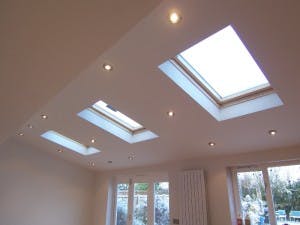Want to know more or get a quote? Get in Touch
Planning Your House Extension - What Are the Rules?
Published Wednesday 27 November, 2013

House extensions are one of the most common home improvements in the UK - we could all benefit from having more space in our homes, and an extension, loft or garage conversion can allow you to achieve this.
The majority of these conversions/extensions won’t require planning permissions as the green light can often be given under permitted development rights.
This post gives you all you need to know about house extension rules and permitted development rights, including exactly what you are allowed to do depending on the type of house that you are planning to extend.
The government wanted to allow more household extension projects to be given the green light without homeowners having to apply for planning permission; in 2008 they changed the planning regulations to allow this to happen.
But unfortunately you cannot simply start extending your house as you wish; the permitted development rights mean that you have to follow specific guidelines that will dictate the design, position and size of the extension in order to be able to go ahead without applying for full planning permission.
There are of course situations where you will need permission from your local authority to extend your home in any case because your rights are different, and if you are unsure it is best to double check. This applies if you live in any of the following:
Under the rules of permitted development rights your house extension cannot cover more than half the area of land around the original house. What they count as the ‘original house’ is how it was when it was first built, or as it was on the 1st of July 1948 if it was built before that date. This means that any extension that was done by the previous owners of your house counts towards this allowance too and should be taken into account in each of the guidelines for the different house types below.
Another rule to be aware of is that your house extension isn’t allowed to be forward of the front of your house, but it also shouldn’t be forward of the side of the house if it is that side that fronts the road.
It is only residential house extensions that are allowed under the permitted development rights, so if you want to extend a flat, maisonette or commercial property then you will need to take a look at the Government’s planning portal to get information specific to your property type.
Below you will find information on what you can do for each house type within permitted development rights. There has been a temporary increase in size limits for larger single-storey rear extensions due to the neighbourhood consultation scheme - these size limits apply between 30 May 2013 and 30 May 2016 and are bolded in brackets in the information below.
On your detached house you are allowed to put in a single-story extension to the rear of the house to a maximum height of 4 metres - this extension can only extend to a maximum of 4 metres (doubled to 8 metres under the neighbourhood consultation scheme) beyond the rear wall of the original house. If you are putting in a multi-story extension this can only extend to 3 metres.
Under permitted development rights a loft conversion is allowed on a detached house at a maximum volume of 50 cubic metres.
For a semi-detached house you are allowed to put in a single-story extension to the rear of the house to a maximum height of 4 metres. Both a single-story or multi-story extension can only extend to a maximum of 3 metres (doubled to 6 metres under the neighbourhood consultation scheme) beyond the rear wall of the original house.
Under permitted development rights a loft conversion is allowed on a semi-detached house at a maximum volume of 50 cubic metres.
For a terraced property you are allowed to put in a single-story extension to the rear of the house to a maximum height of 4 metres. Both a single-story or multi-story extension on the terraced house can only extend to a maximum of 3 metres (doubled to 6 metres under the neighbourhood consultation scheme) beyond the rear wall of the original house.
Under the permitted development rights a loft conversion is also allowed, but to a smaller maximum volume of 40 cubic metres.
We have a wealth of experience in house extensions, loft and garage conversions, and have helped many customers to navigate the often confusing world of planning rules and regulations. Please give our expert team a call on 01924 871 044 or 0113 283 9710 to discuss planning your house extension in Leeds or Wakefield.
Interested? We'll call you back
Leeds, Wakefield, Bradford, Huddersfield, Halifax, Harrogate, York, Pontefract, Castleford, North Yorkshire, West Yorkshire, South Yorkshire
Want to know more or get a quote? Get in Touch
Read more testimonialsMatt and his team completed a single storey kitchen extension which has given us a great family space and larger utility area. They were very professional throughout the project, considerate to us and our neighbours, ensuring minimal disruption. We would not hesitate to use them again or recommend to our friends. Thank you to all at Dobsons!
Jackie Hanmer